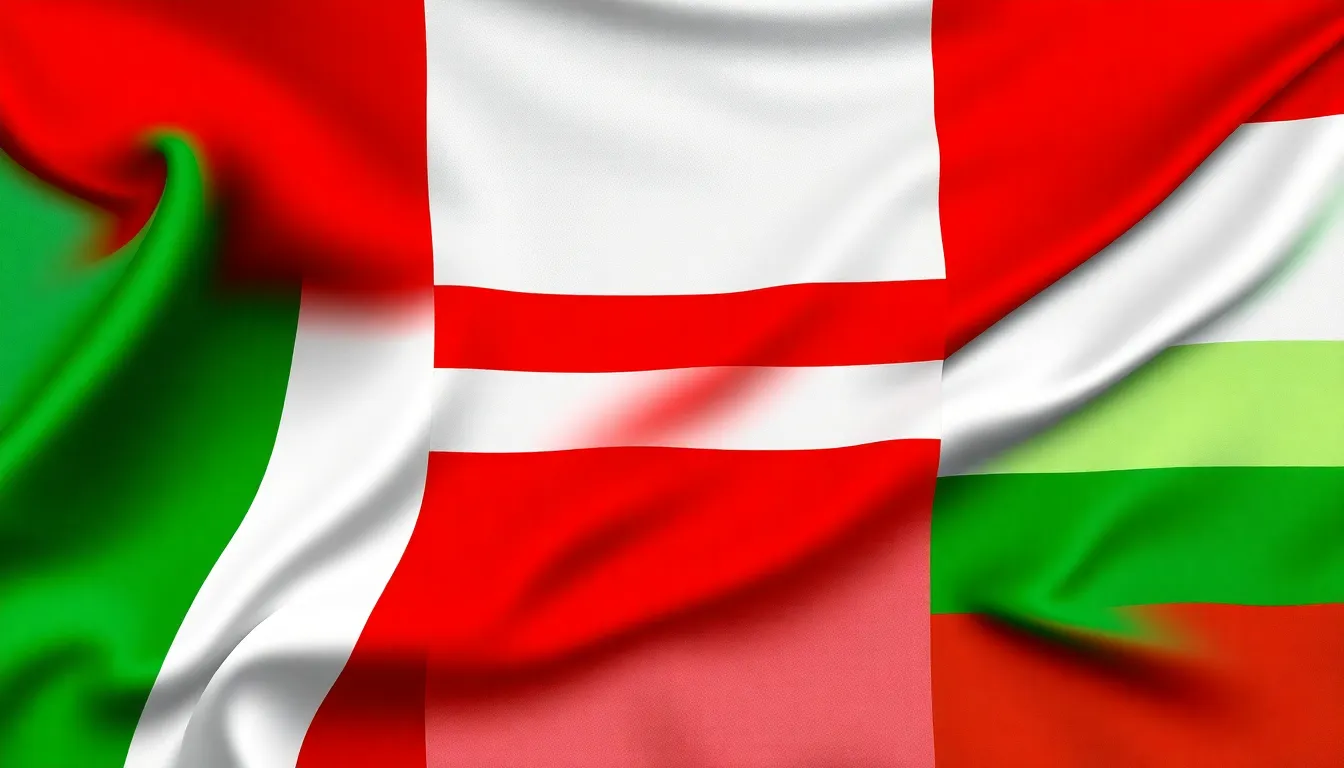Flags often tell stories of culture, history, and identity, and the red, white, and green combination is no exception. This striking color palette is featured in the flags of several nations, each representing unique values and traditions. From the vibrant landscapes of Italy to the rich heritage of Hungary, these colors evoke a sense of pride and belonging.
As curiosity sparks about the flags that share these colors, it’s essential to explore their meanings and the countries they represent. Whether it’s the symbolism behind each hue or the historical context, understanding these flags can deepen appreciation for the nations they symbolize. Join in as we uncover the significance of the red, white, and green flags around the world.
Table of Contents
ToggleOverview of Red, White, and Green Flags
Red, white, and green flags represent various countries, each embodying unique cultural and historical values.
Italy
Italy’s national flag features three vertical bands of green, white, and red, symbolizing hope, faith, and charity. These colors reflect Italy’s rich history and the struggles for independence.
Hungary
Hungary displays its national colors with three horizontal stripes of red, white, and green. The colors signify strength, fidelity, and hope, representing the nation’s storied past and aspirations.
Mexico
Mexico’s flag incorporates red, white, and green with an emblem featuring an eagle. The colors not only represent the blood of national heroes but also symbolize unity and independence.
Bulgaria
Bulgaria adopts a horizontal tricolor of white, green, and red. The white stands for peace, the green represents the agricultural wealth, and the red symbolizes bravery.
Iran
Iran’s flag showcases green, white, and red with intricate designs, where green symbolizes growth, white denotes peace, and red reflects courage. The emblem at the center signifies the unique cultural identity of Iran.
These flags denote historical events, cultural pride, and national identity, providing an enriched view of the nations they represent. Each combination of red, white, and green offers insight into the values cherished by their respective peoples.
Countries with Red, White, and Green Flags

Several countries incorporate red, white, and green in their flags, reflecting diverse cultural meanings and historical narratives.
Italy
Italy’s flag features three vertical stripes: green, white, and red. Green symbolizes hope, white represents faith, and red stands for charity. This tricolor design dates back to the 19th century and has evolved as a national emblem, encapsulating the Italian spirit and heritage.
Hungary
Hungary’s flag consists of three horizontal stripes: red, white, and green. Red signifies strength, white reflects fidelity, and green denotes hope. This flag’s origins trace back to the medieval era, emphasizing Hungary’s enduring identity and aspirational values, fostering national pride.
Bulgaria
Bulgaria’s flag is composed of three horizontal stripes: white, green, and red. White represents peace, green symbolizes agricultural wealth, and red signifies bravery. Established in 1885, this flag illustrates Bulgaria’s agricultural roots and the resilience of its people throughout history.
Symbolism of Colors in Flags
Colors in flags symbolize various values and historical contexts, serving as representations of national identity. The combination of red, white, and green presents distinct meanings across different cultures.
Red
Red symbolizes courage, strength, and valor in many flags. It often represents the bloodshed in the quest for freedom or independence. For instance, in the flags of Italy and Hungary, red highlights resilience and the sacrifices made throughout history. In Mexico’s flag, red signifies the blood of national heroes, reinforcing the connection to independence and unity.
White
White commonly embodies peace, purity, and integrity. Flags that include this color, like Italy’s, reflect ideals of hope and charity. In Hungary’s flag, white conveys fidelity and aspiration, promoting a sense of unity among its people. Additionally, Bulgaria’s flag incorporates white to represent peace and the nation’s commitment to harmonious coexistence.
Green
Green frequently symbolizes growth, fertility, and prosperity. In Italy’s flag, it stands for the country’s lush landscapes and agricultural wealth. Hungary’s use of green represents hope for a fertile future, while Mexico’s flag showcases green as a sign of independence and lasting unity. Bulgaria’s flag, too, incorporates green to express agricultural abundance and the resilience of its people.
Historical Significance of the Flags
The flags featuring red, white, and green carry rich historical significance, embodying cultural pride and identity for various nations.
Italy
Italy’s flag, adopted in 1946, has roots tracing back to the late 18th century. The vertical stripes symbolize hope, faith, and charity, integral to Italian heritage. The red represents the blood shed for independence, white signifies peace, and green reflects the country’s lush landscapes.
Hungary
Hungary’s flag, established in 1957, emphasizes its medieval origins with horizontal stripes representing strength, fidelity, and hope. The red denotes bravery in battles, white symbolizes the quest for peace, and green reflects hope for a prosperous future.
Mexico
Mexico’s flag, recognized in 1821, showcases a unique emblem where red signifies the blood of national heroes, white represents purity, and green symbolizes independence. The eagle and snake in the center of the flag further emphasize unity and resilience.
Bulgaria
Bulgaria’s flag, adopted in 1990, contains horizontal stripes that reflect peace, agricultural wealth, and bravery. The white symbolizes peace, green signifies the nation’s agricultural abundance, and red represents the courage and sacrifices of the Bulgarian people.
Iran
Iran’s flag, officially adopted in 1980 but with historical roots, features a complex emblem with rich symbolism. The green symbolizes growth and prosperity, white for peace, and red for courage, signifying the strength and identity of the nation.
These flags collectively portray a tapestry of history, aspirations, and values shared by their nations, enhancing the appreciation of national identities entwined with red, white, and green.
The red white and green flags represent much more than mere colors. They embody the rich histories and cultural identities of the nations they belong to. Each flag tells a unique story of hope strength and resilience that resonates deeply with its people.
Exploring these flags reveals a tapestry of values and traditions that shape national pride. Understanding their significance enhances appreciation for the diverse cultures around the world. Whether it’s Italy’s celebration of charity or Mexico’s emblematic unity these flags serve as powerful symbols of the aspirations and dreams of their nations.




